F-5 Pilot's Early Struggles Aerial Refueling The Underpowered Jet
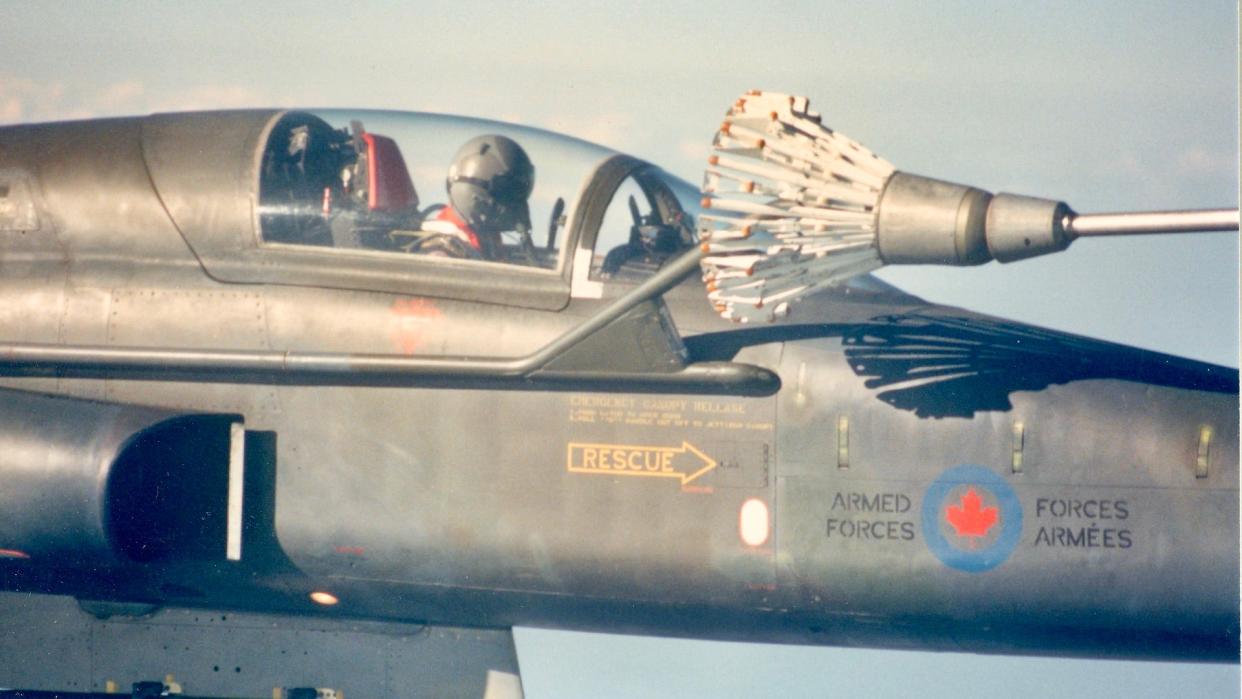
I cursed into my oxygen mask, as my little fighter wallowed in the thin air above 20,000 feet, dropping inexorably behind the Boeing 707 tanker. The day before, the same jet had felt very responsive – but that was at 420 knots at 100 feet above ground, in the cold, dense northern Alberta air mass.
Accelerating to 480 feet for the practice target run-in was a bit of a chore, though, because the CF-5 fighter-trainer was ‘hogged up’ with two underwing fuel tanks, a rocket dispenser, and a practice bomb dispenser, plus wingtip fuel tanks. The huge drag from all those external stores made the two little J-85 jet engines work very hard to keep up combat speed, and I even had to stroke a bit of afterburner (AB) to get up to my attack speed.
Now, at much higher altitude, and behind a tanker that was flying at only 295 knots, the jet that had felt so responsive and powerful at high speed and low altitude was acting more like an elephant calf mired in mud. “Pig. Cow.” were words that were coming out of my mouth, for my sole enjoyment in my helmet’s speakers.
I wallowed behind the basket trailing from the refueller’s wingtip. Alone in the aircraft, I was still very much aware of multiple sets of eyes watching my attempts to plug my probe into the drogue, or basket. Some were in the cockpits of other fighters clustered nearby, while many others were at the windows of the converted Boeing 707-320 tanker that Canada called the CC-137.
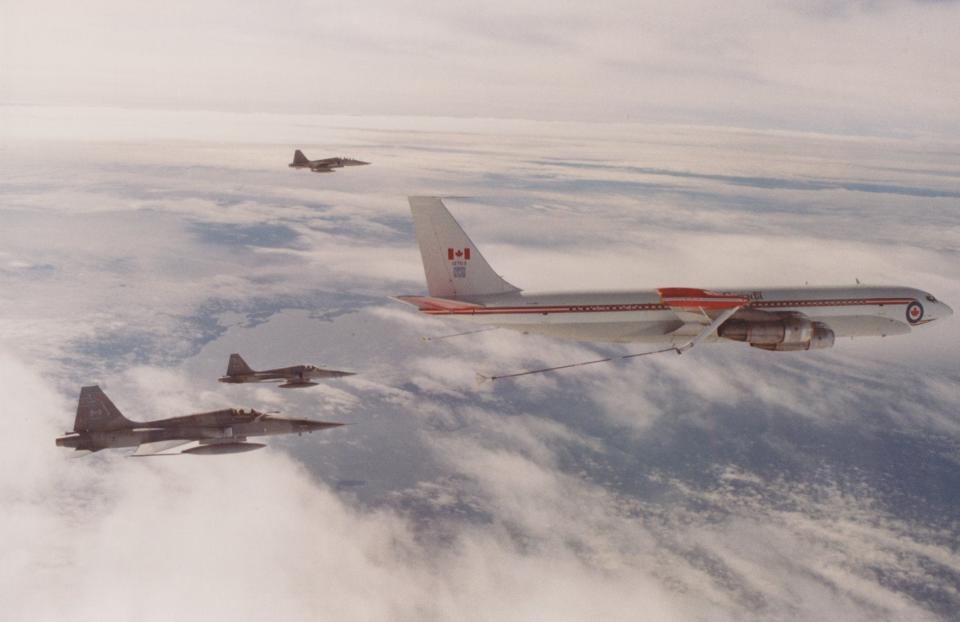
As I took another stab at plugging in, the 300 pound basket swung toward the nose of my fighter. Panicked, I sucked back both throttles, then realized that I had pulled off too much power, too fast. I was drifting aft and unable to stop sliding backward without using afterburner.
Crap.
This was even tougher than the briefings made it out to be!
I took a deep breath, trying to ignore the fact that the tanker and three other fighters were all burning fuel and time, and that I was being judged by all present on how I was doing. Clear your mind. Think. I reviewed what the instructors had said in the lecture the week prior, as well as in the pre-flight brief.
On paper – or at least on the white board in the briefing room – it looked relatively straightforward. My CF-5 Freedom Fighter had a refuelling probe which had to be flown into the basket. Compared to almost everything else we did in the fighter-lead-in training course, though, there would be a major difference. When learning something for the first time, I would fly in the front seat of a Dual (two-seat CF-5), with the instructor in the back. Using his controls, he would demonstrate a maneuver, and I would get to see what it looked and felt like, as well as what the controls were doing.
After the demo, it would be my turn to mimic what he’d done, while the instructor could coach me or even make small inputs on the controls so I could avoid making catastrophic errors. Today, this was impossible: only the single-seat CF-5 had an AAR (air-to-air refueling) probe, the Dual did not. So the first time I refueled in flight would be by myself, with only drawings on a white board and a verbal briefing to guide me. There were also no simulators for this.
Even 40 years later, simulation does a poor job of providing AAR training, due to various technical limitations. After I retired from the military, I worked as a test pilot on advanced CF-18 Hornet simulators that allowed pilots to experience the ‘sight picture’ and initial moves required to refuel. Even with those systems, however, nothing could replace actually doing the job in flight. Happily, the Hornet has dual-seat versions that also have retractable probes. This was a luxury I fervently wished I had today in my vintage Cold War jet – but in a way, it actually enhanced my burgeoning fighter pilot street cred to accomplish this the old-fashioned way — solo — with only myself to blame for whatever happened.
Why were we hogged-up with heavy configuration? Simple. The tanker had been scheduled months in advance, and was only with us a few days, during which everyone would get a stab (so to speak) at tanking. We were also behind schedule on the fighter lead-in training course, so we flew some ground attack with the aircraft that were not tanking – but all jets were in heavy configuration regardless of what mission they would fly that day. The ‘fighter from Mattel’ as we derisively called it, was not designed to carry a heavy load. It had limited thrust, and very limited on-board fuel. Any time we carried bombs or rockets, even a practice bomb dispenser, it increased the drag on the jets.

For refueling practice, the tanker flew at 20,000 feet, at 295 Knots Indicated Air Speed (KIAS). At 250 to 300 knots, the CF-5 wallows and barely stays in the sky. That is far too slow for it to operate and maneuver like it does around 400 KIAS. At this heavy weight, the poor little jet was operating near its maximum lift over drag (L/D max) point.
Why does this matter? Simply put, the normal relationship between power required and speed actually works in reverse when slower than L/D max speed.
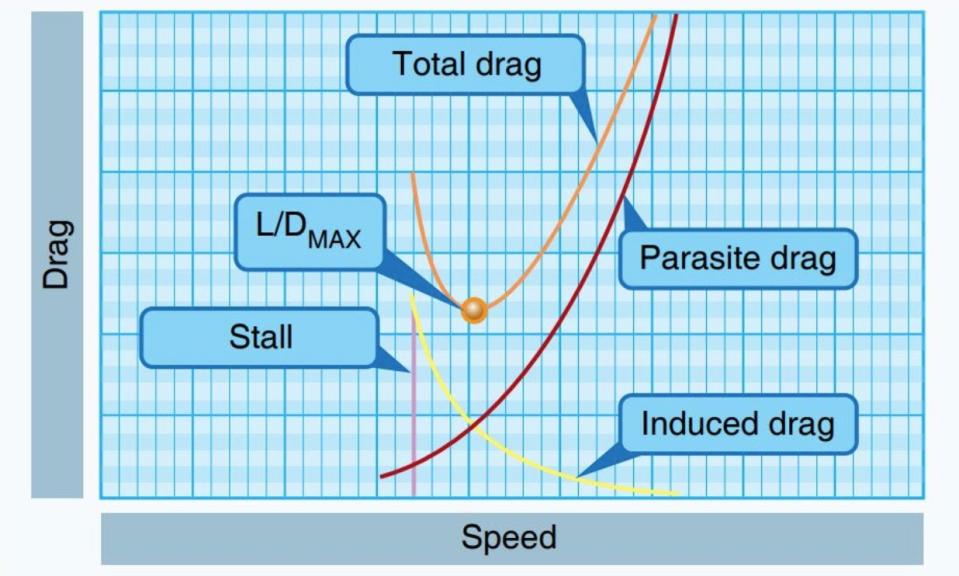
When an aircraft flies faster, it usually needs more power, just like you need to push down further on the gas pedal in a car to maintain a higher speed. When the aircraft drops below its L/D max speed, things operate in reverse. At L/D max (somewhere around 250 knots in a CF-5 with no external stores), it needs the least amount of power to maintain level flight. If you slow down, though, the induced drag (drag that results from producing lift) actually increases, and more power is needed to fly slower! This is what pilots call falling ‘behind the power curve.’ In extreme cases, it’s possible to have insufficient thrust, even with full military power (full throttle without afterburner), to maintain level flight.
Today my L/D max speed was several knots higher than 250 knots because of the increased weight. Heavy, the CF-5 flew like a drunken pig at speeds around 280 to 290 KIAS. Our instructors, many of whom had flown the CF-5 operationally, were quite familiar with the limitations of the aircraft. They had experienced the inability of the little fighter to carry a heavy load and maneuver. They told us how to work around the jet’s lack of power when heavy at slow speed behind the tanker.
We were briefed that we should snick one engine into minimum afterburner (min AB), which would instantly add a bunch of thrust. Each of our engines produced 3,000 lbs of thrust without AB, but in full AB they each had almost 50 percent more thrust (4,300 pounds). Like most fighters, it was possible to modulate the thrust in AB, so pushing one into min AB would provide just enough extra thrust to allow the poor little jet to keep pace with the Boeing.
Unfortunately, the amount of thrust modulation available in the AB range was quite limited, so putting both engines into AB would have been too much. Using one engine in AB, and pulling the other throttle back slightly would do the trick. The extra bit of thrust generated by one engine in min AB would allow the other throttle to be used to control fore and aft positioning vis-à-vis the tanker.
Easy, right?
Nope.
The other thing we were taught about refueling was that yaw (side to side motion of the nose) control was critical. The probe sat just to the right of the cockpit, and even a tiny swing of the nose from side to side would cause it to miss the basket laterally. So, playing with the throttles asymmetrically was definitely a problem, because every adjustment of the single engine not in AB would cause the nose (and the probe) to swing sideways.
Sheesh.
During the classroom session, we had also learned of the danger zones around the tanker. Even in cruising flight, a big aircraft like the 707 trailed ‘wingtip vortices’ behind it. High-pressure air below the wings tends to curl upward at the wingtip, to fill the lower-pressure zone above the wing. This creates powerful little horizontal tornadoes or vortices that trail behind the wingtips.
The hoses trailed just below those deadly vortices – behind the wingtips. This meant that if I missed hitting the basket on a tanking attempt, I had one place to go to avoid hitting the heavy steel basket as I repositioned: back, and down.
The worst outcome of a failed contact attempt was not missing entirely, but hitting the edge of the basket, causing a ‘tip-off,’ which meant the basket would swing wildly away from the probe’s tip, and almost certainly hit the fragile skin of the fighter.
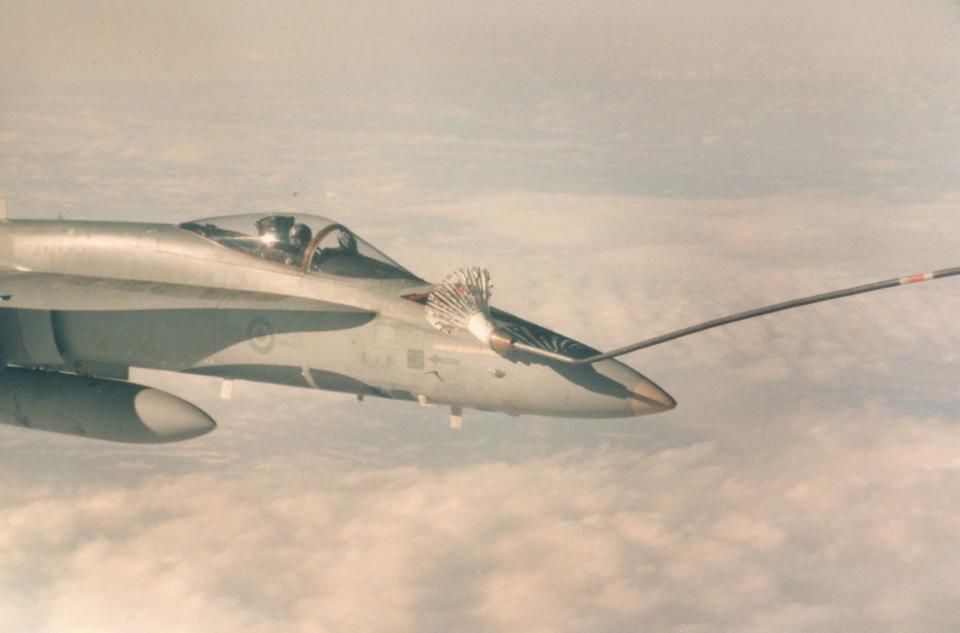
If I hit the basket just a little too high, the basket would bend downward, swing around, and try to hit my aircraft’s fuselage from below. The natural tendency for a pilot experiencing this is to pull up. We were told about one CF-5 pilot who had done just that. His aircraft rose into the wingtip vortex, and the little fighter was flung up and toward the 707, like a toy. He madly attempted to stop the roll into the refueling tanker, and was only able to regain control after he had passed inverted just above the vertical tail of the big 707.
If he had hit the 707’s tail, it would have caused the tanker aircraft to crash, killing all on board. A fighter pilot, if he survives the initial impact, can always eject. Tanker crews do not have that option. AAR is an exercise of extreme trust between radically different aircraft types with different roles and training.
Today’s mission had started well. After takeoff, we contacted a NORAD controller, who vectored us toward our tanker’s orbit to the north of Cold Lake, Alberta. Lead (an instructor flying from the back of a dual) got us into position on the tanker – he and number two were flying echelon left on the 707’s left wing, and I flew outboard of number three on the tanker’s right wing in echelon right. Apart from lead, there were three students in single-seat jets, all nervously watching the others and worried about the difficulty of the task to come.
The lead, in the dual without the probe, was cleared astern the left hose, and he made it look easy as he expertly slid down, back, and over, stabilizing behind the hose. He was cleared for a ‘simulated contact’, and moved forward until in a position where if he’d had a probe, it would have plugged in. We all flew slightly loose formation so we could watch how he did it, and the instructor flying from the back was talking to the student in his front seat about sight picture and asking him to gently follow through on the controls to see how it was done. The instructor made it look easy, so all of us had a surge of false confidence that would soon be dashed.
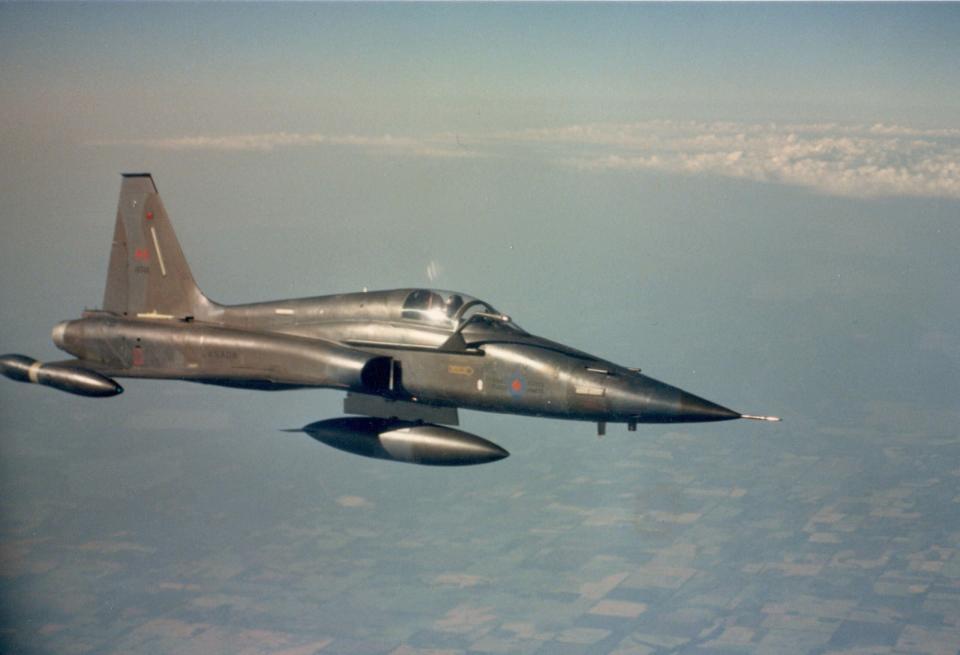
Two students – number two on the left wing, and number three who was next to me on the tanker’s right wing, were cleared astern their respective hoses. I watched with growing trepidation as I saw first one, then the other struggle to perform what the instructor had made appear to be a simple task. Wallowing, noses swinging side to side as they played with afterburners. Bobbing violently near the basket, and narrowly avoiding having the heavy basket scratch their canopies or dent their metal fuselages. Eventually, each managed to get a couple ‘dry’ plugs, then each took some fuel on their third plugs.
When my turn came, the voice from the tanker calmly said “Four, cleared astern the right hose.” I had been flying echelon right on number three – outside of his position on the tanker’s right wing. I dropped slightly back and down from three, then slid across behind him until I was directly aft of the hose.
The 707 had a pod on the wingtip from which the hose trailed. The basket looked like a badminton bird, but it was not soft and light. It was made out of steel, and weighed about 300 pounds. I had a healthy respect for that basket, and above all I didn’t want to be the one to have damaged an aircraft – like some of my coursemates had done the day before.
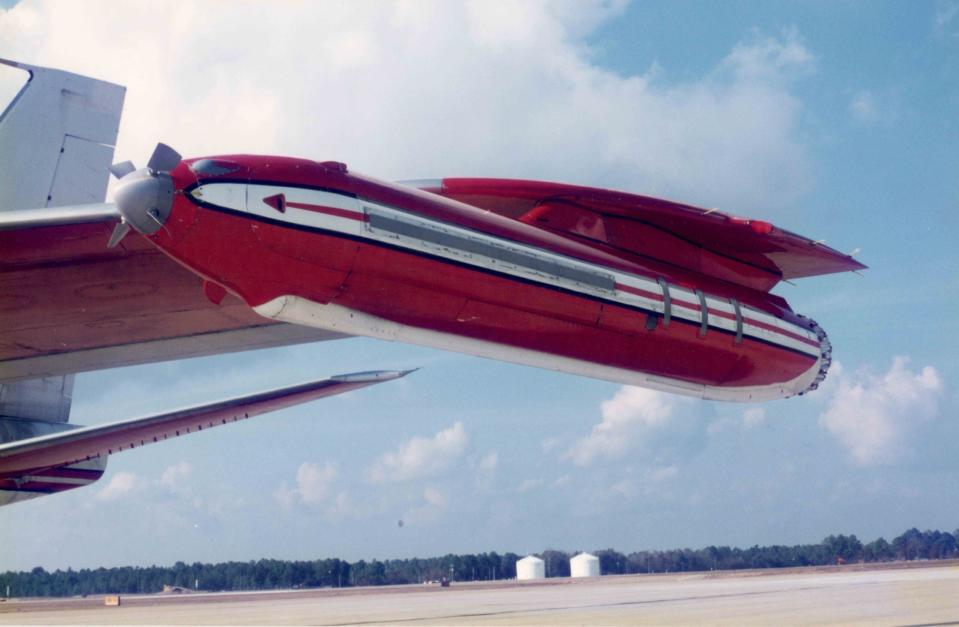
Finally, I was in position behind the basket. The calm voice then said, “Four, cleared dry contact, right hose.” I made sure I had the right ‘sight picture,’ so that I’d be in the right place to move forward and plug. All formation flying was done with visual references, and flying toward the basket was just like formation flying – except that my goal was to hit it, not just fly next to it like a sane person would.
The instructor had drawn an offset figure 8 on the white board. The top circle was the bellmouth. The lower circle, offset to the right, represented the basket itself, trailing below and slightly outside the bellmouth. On the right wing, the vortices dragged the hose to the right (away from the wingtip), while on the left side the figure 8 was reversed, with the hose trailing to the left of the bellmouth. Today, after seeing Star Wars, I would call it a ‘BB-8’ shape, with a large circle (basket) below a smaller circle (bellmouth).
The whole idea was to stabilize about 10 feet behind the basket, gaining the figure 8 sight picture, and to keep that picture by adding power and moving smoothly forward, with a few knots of closure, until my probe inserted itself into the basket. No, we didn’t aim for a specific speed on our instruments. Eyes outside, the technique was to judge visually what a few knots of closing speed was.
All along, the key was not to look at the basket, but to focus on the bellmouth. If I looked too much at the bobbing basket, I would induce vertical oscillations in my aircraft, and miss the basket – or cause a ‘tip-off.’
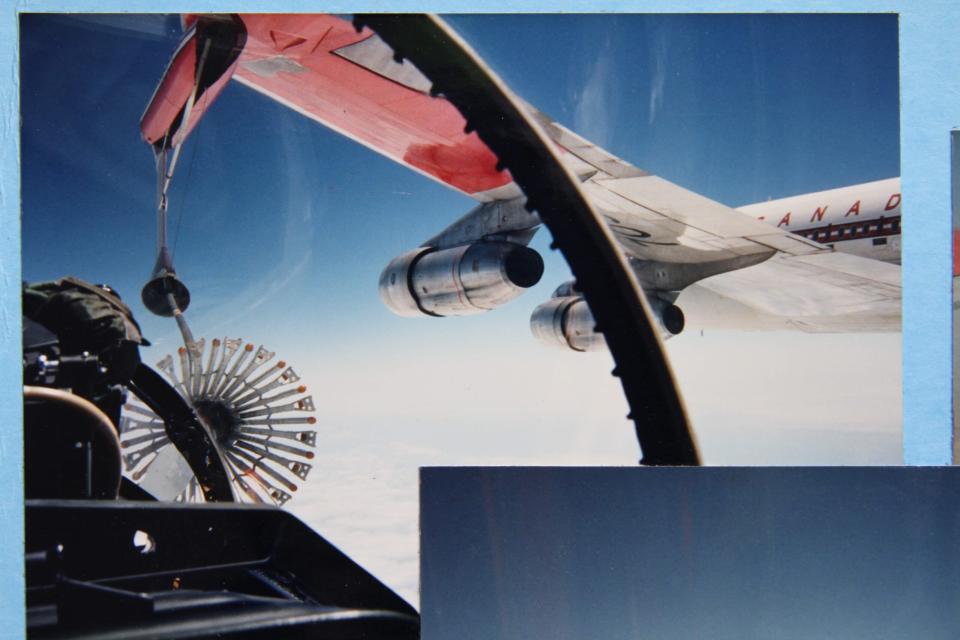
Another tidbit they told me about was how the basket would appear to be too close to my windscreen as I approached, but at the last moment it would be pushed away from my aircraft by the air flowing around my nose (the bow wave, just like a boat). In other words, until just before contact, it would look like I’d actually have smashed the delicate windscreen into the heavy steel basket. Again, I wished fervently for a demonstration of what it would look like. Of course, that was not an option.
The difficult part, achieving contact, was partly aided by a quick glance at the basket and probe as they made contact, to make sure they were not misaligned. Minor adjustments (pressure on a rudder, or a small vertical stick input) could be made at the last moment, but it was always key to not stare at the basket and end up oscillating vertically.
The instructor told me that the way to know I was in proper vertical position was that I’d feel a slight ‘tickle’ of turbulent air on my vertical stabilizer. Not to worry, he said – this was normal, just the presence of the (deadly, my mind filled in as he spoke) vortex immediately above my aircraft. This tickle would intensify as I advanced and rose slightly toward the contact position.
All of this briefing went through my mind as I sat about eight feet behind the gently bobbing basket. It had all seemed so straightforward in the comfort and safety of the briefing room. The reality, though, was less simple. My throttles were fully forward, just behind the afterburner regime, and I was just barely keeping up with the big 707. With the two circles lined up the way the drawing had been on the board, I pushed both throttles forward until I felt the resistance where AB would start. The aircraft didn’t exactly surge forward – it reluctantly advanced at the pace of a toddler heading somewhere he didn’t want to go.
The probe on the CF-5 sticks well out ahead of the windscreen, and to the side. As I approached the basket, it looked at first as if it would miss the probe to the right, but as advertised, the ‘bow wave’ from my aircraft pushed it out slightly when I got really close. I stole a glance at the basket, but looked too long and started to bob up and down. Throttles back in fear. Dropping back too quickly!
Crap.
This was not going well, and several people were watching my failures. I felt tremendous pressure, knowing that the other two students had succeeded, and now I was the last one to prove himself.
I reminded myself that the other students had also been afraid and that number three had taken several attempts before finally plugging in twice in a row. Second try. This time, I managed to avoid staring at the basket, but got a tip-off, the basket swung up, and I pushed down gently, avoiding it. I moved back slightly and tried again. Another tip-off, only this one pushed the basket down and inward, toward my nose.
I panicked.
My gut reaction was to pull up and away from the basket that was threatening to hit the nose of my airplane from below as it swung in an arc toward me. Before my mind engaged, I instinctively pulled back slightly on the stick. Immediately, I felt a worsening of the vortex burble on my vertical tail. Uh-oh. I was about to be thrown over top of the tanker. I pushed forward, hard.
My feet came up off the rudder pedals, and I felt my stomach flutter as the negative G hit momentarily. I was silently thankful for having my dark visor in place, so the dead flies and dirt that flew upward from the floor didn’t get in my eyes.
Phew!
I missed the basket, and didn’t get flipped over the tail of the tanker, but that was too close. The instructor in the lead aircraft came on the radio to tell me to relax, gave me a couple of pointers, and said to try again. The calm voice from the tanker cleared me once again for a dry contact.
How could he be so calm when I almost managed to get flung into his aircraft, killing them all?
This time, I bobbled slightly as the probe was about to hit the basket, but it contacted only a bit off center, and the basket slid into contact with the probe. Yes!!! I kept the aircraft moving forward after contact. The hose had three rings painted on it. After contact, the fighter had to keep pushing the hose into the bellmouth. The refueling system was designed so that it only delivered fuel when the hose was pushed in somewhere between the front and rear orange rings. This prevented a soft contact between probe and drogue, and ensured fuel wouldn’t vent out around the probe as it flowed. The goal of the fighter pilot was to maintain a perfect position fore and aft where the hose’s center ring was just visible at the rear of the bellmouth, thus ensuring the hose was in the middle of the allowable fuel-delivery range.
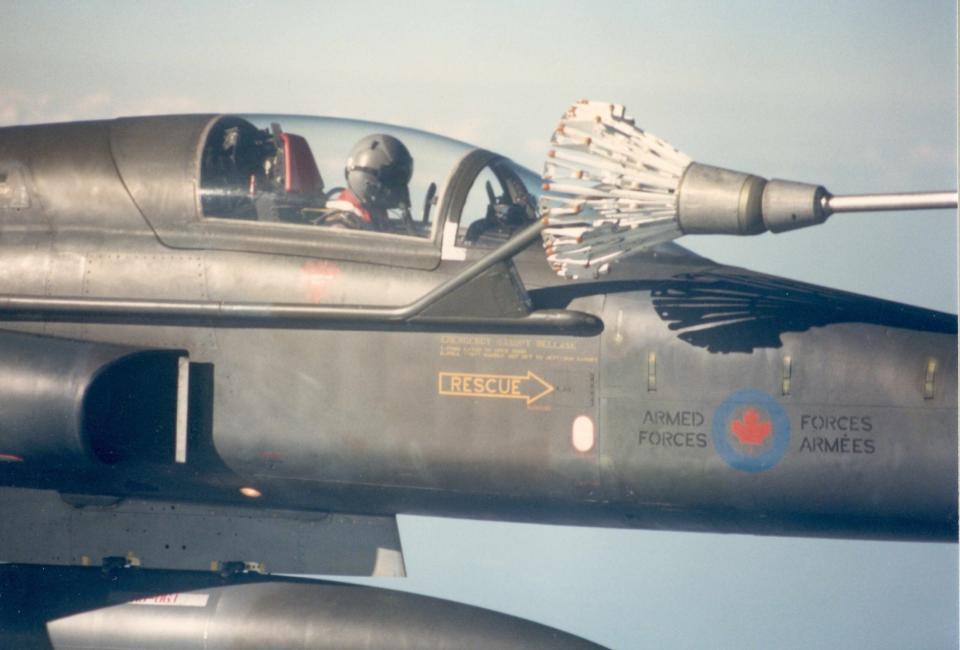
I saw the first orange ring disappear into the bellmouth, and eased the throttles back ever so slightly to keep the middle ring at the bellmouth – but I saw the hose start to lengthen again, as I overcompensated. I slammed both throttles to MIL power, and barely arrested my backslide, stagnating behind where I should ideally be.
“Four, cleared disconnect, right hose.” I eased both throttles back very slightly, and concentrated on being in the right position vertically when the hose got to where it would disconnect. The basket came off my probe, flying abruptly up. I had been a little too low when it released, and the basket oscillated vertically a bit until it settled down again. I took a mental note of what it had looked like, and vowed to be higher when I disconnected the next time.
The tanker cleared me to try another contact, this time ‘wet,’ for a fuel top-up. I connected the first time (YAY!), and pushed the hose into the bellmouth. I’m sure my grin was so wide that everyone watching could see my oxygen mask move with it. The green light in the bellmouth came on, indicating fuel was flowing into my aircraft. I anticipated how the extra weight would demand more power, and kept nudging the throttles forward, but soon found that despite being in MIL, I was slowly sliding aft. I could see the center ring on the hose inexorably creep backward away from the bellmouth.
One throttle into burner, and quickly retard the other a little to avoid running forward into the tanker. Control the slight nose swing with a rudder. After a couple of minutes, the green light went out, and the orange one came on, meaning fuel transfer was complete. The tanker called to tell me to disconnect, so I pulled the right throttle out of AB with two fingers, matched the throttles near MIL by dragging the left-hand one forward with my little finger, and allowed myself to slowly drift back. This time when it disconnected, a little mist of fuel came out from the connection. I noted with pleasure that I had corrected my vertical position – the basket barely bobbed as I disconnected cleanly.
Time to check the fuel quantity. Aware that I was still close to the basket, I used my usual close formation technique. Think: what am I looking for? Where is the gauge? What information do I need to glean from it, and in what format? Needles? Numbers? Glance quickly down at the fuel gauge, take a mental photograph without processing the information, then eyes immediately back to the bellmouth, and mentally digest the information. The fuel gauge read near full, as expected.
All of us managed to plug successfully a couple of times that day, and among my coursemates only a bit of damage was done to the aircraft. I felt a swell of pride.
Mission accomplished.
I’d managed to refuel, and hadn’t damaged my aircraft. The AAR dragon had been slain, despite being in a heavyweight CF-5.
Retired Major Dan McWilliams logged 3,200 hours over 20 years in the Canadian Air Force, flying the CT-114 Tutor, CF-5, T-33, and CF-18. A specialist in Electronic Warfare and software, he managed a group of engineers developing mission-critical software for the CF-18 and for CF-18 simulators. He later flew and instructed in the Challenger 604, tested full-mission simulators for military customers, managed a CF-18 mission training center, and taught at an aviation college.
Contact the editor: tyler@thedrive.com

